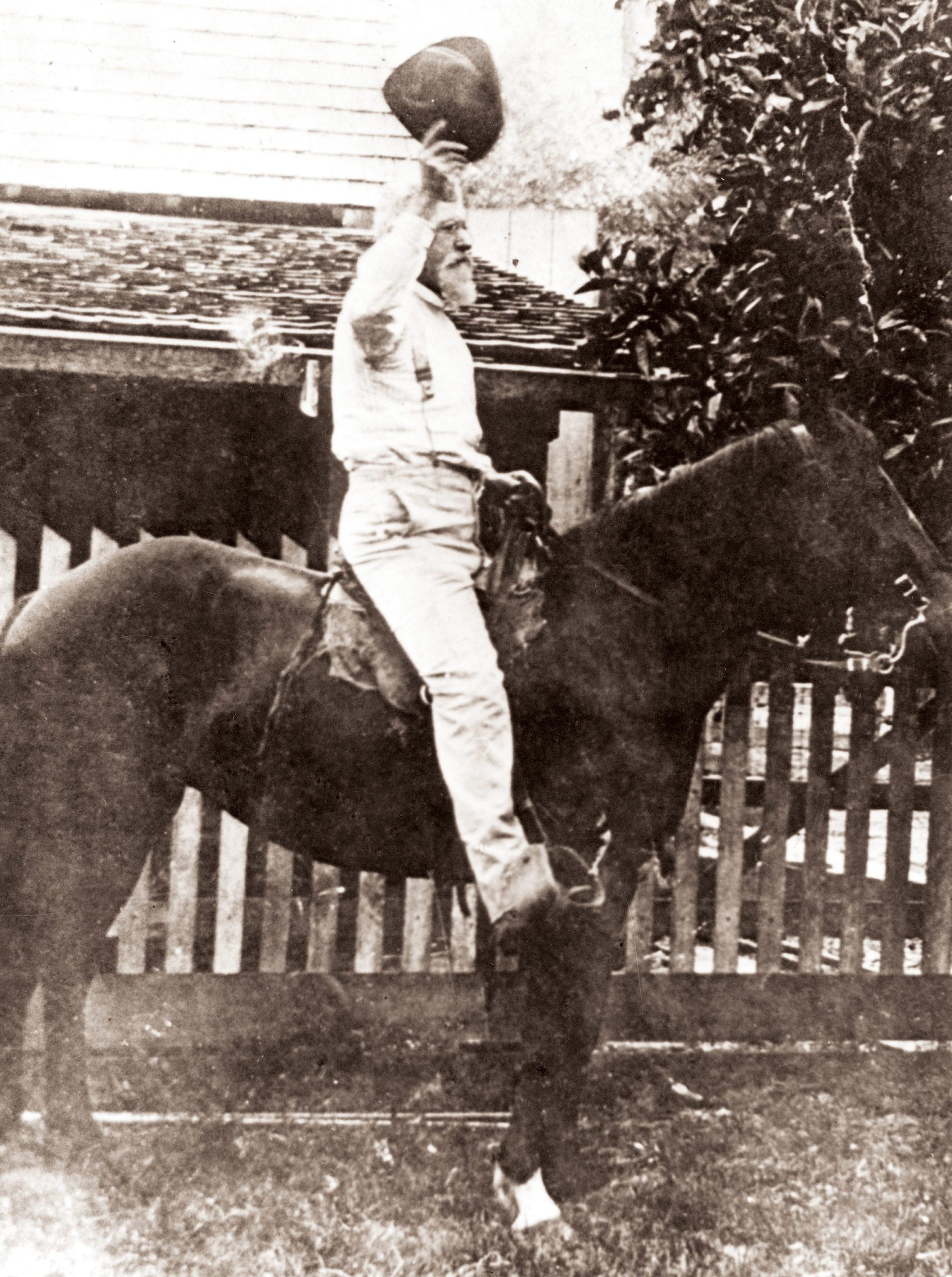Hendry is more than a name of a Florida county. Or a street in Fort Myers. Or the name of a Fort Myers lawyer or Fort Myers Beach newspaper editor or Collier County deputy.
Since before there were places called Lee or Collier or, yes, Hendry County, the Hendry family has been here.
They’ve made history since before Fort Myers incorporated in 1885 or Lee County was carved out of Monroe County in 1887.
 |
|
Descendants of Capt. Francis Hendry pose by the street sign in downtown Fort Myers bearing his name. Brian Tietz |
Whenever something needed to be done in the past 150 years or so, a Hendry has been involved, it seems—from serving as Fort Myers mayor to running a hotel to planting the city’s famed palm trees to working as a cop or city clerk. That remains true today. You’ll find Hendrys practicing everything from law to dentistry to photography and local journalism to law enforcement.
Here a Hendry, there a Hendry, everywhere, it seems, a Hendry.
Keri Hendry Weeg, associate editor of the Island Sand Paper on Fort Myers Beach, knows about growing up a Hendry.
“It’s almost like you should be in a museum,” Weeg says.
Only with a family as vibrant as hers, no one can ever accuse them of being relics.
The family saga starts with the nearly mythic figure of Captain Francis Asbury Hendry, dubbed “The Father of Fort Myers.”
A widely published photo of Capt. Hendry, as he’s still known to descendants and history buffs, shows a man late in life who could have ridden a horse straight out of Ken Burns’ Civil War series.
His steely, no-nonsense, I’m-tougher-than-any-son-of-gun features were adorned with a white goatee. He sat astride his horse with the ease and comfort one would expect of a 19th-century cattleman and cavalry officer.
The captain came to Florida in 1851 at age 17 when he helped drive a herd of cattle from Georgia to central Florida. The state, incorporated just six years before, was wild and untamed, dotted with tiny towns and the occasional outpost along a river or bay.
Something must have resonated with the young adventurer. Two years later, he traveled to what was then known as Fort Harvie, an Army base on the Caloosahatchee.
During the Civil War, Hendry served in what was known as the Cow Cavalry, a Confederate force that attacked Fort Myers (when it was a fort and not yet a city) and tried wresting it from Union forces.
The Battle of Fort Myers was a Union victory. But Capt. Hendry and his progeny were not done with Fort Myers. Not by a long shot.
In 1870, Hendry moved full-time to Fort Myers—again, by way of a cattle drive, steering 12,000 head of cattle from Fort Meade through palmetto brush and slash pines and swarms of mosquitos. In his new community, he became a cattle baron, civic booster, businessman and father—of 11. He helped incorporate the town of Fort Myers, served on the first city council, and was among the founders of Lee County.
In 1895, he set his sights east and is credited with establishing the town of LaBelle, which he named for his daughters, Laura and Belle. The county in which LaBelle sits came to bear his name, and the clan’s transformative hands began to shape the region’s development.
Despite all the family has achieved, some feel their name and legacy are unknown to most newcomers and tourists.
“It means very little to the public,” says Kevin Hendry, a Collier County sheriff’s deputy. But it still means everything to the family. Kevin Hendry followed the captain’s military example, serving in both the Army and Marines before becoming a law enforcement officer. And in his possession he keeps a family treasure—a book detailing the clan’s history and members. It’s 847 pages long.
Everywhere A Hendry
By the late 1800s, the family were so well-known that their deaths made front-page news.
 |
|
Cattle at the Hendry ranch. |
“Aunt Sue is no more, and the town of Fort Myers is in mourning,” The Fort Myers Press lamented in 1899 at the passing of Mrs. W. M. Hendry, from an unspecified medical condition. “… She took it with calm resignation of one who was prepared to meet the Heavenly Father.”
“Mrs. Hendry, wife of Mayor Louis A. Hendry, breathed her last at noon on Monday,” the paper reported in 1904.
“Fred E. Hendry, 59, Drops Dead Here,” screamed a headline on a Tuesday in August 1944. “Fred Earl Hendry, 59-year-old gunnery school employee, died of a heart attack yesterday morning while eating his breakfast in the Blue Goose restaurant on First Street,” the paper reported.
Capt. Hendry’s grandson, the horticulturist James E. Hendry, got this recognition in The News-Press after his fatal 1955 car crash on First Street in downtown Fort Myers: “His monument is the stately beauty of the royal palms and the gracious greenery or the hundreds of other trees which he planted and nurtured along the streets of the community and which have made it known throughout the land as the City of Palms.” He died when his Everglades Nursery truck collided with a police car.
More troubling were the 1982 headlines reporting the death of former Collier County Sheriff E. A. “Doug” Hendry, who shot himself in the head with a .32-caliber handgun. He was 58.
Alcoholism drove him to it, according to a News-Press account. But he wasn’t a bad person or bad cop, according to the paper. He was described as “almost larger than life” and “probably the best sheriff you could find anywhere in Florida.”
The News-Press added, “Hendry was also a rarity among Florida sheriffs at the time—he was honest.”
The Legend Dies; The Family Endures
In 1908, Capt. Hendry wrote a history of Fort Myers and near the end of it he looked back and remarked on how much had changed since his first visit in 1853.
“Had we old-timers in that day been told that the year 1908 would be ushered in and find Lee County and Fort Myers what they are today, with a railroad terminal within the corporate limits of Fort Myers and the hundred and one up-to-date utilities, and our Lee County with a population of five or six thousand inhabitants, it too, the most prosperous county in the state, we would have shrugged our shoulders with skeptical significance,” Capt. Hendry wrote.
 |
|
Capt. Hendry and his wife, Ardeline Ross. |
The community understood his significance, however. When the captain died in 1917, it was front-page news in The Fort Myers Press.
“After months of ill health, the end came to him peacefully at 9:20 o’clock last night at the home of his daughter,” the paper reported.
The Press detailed his services as a state senator, mayor, county commissioner and his faith as a member of the Methodist church. He was regarded as an “exponent of fair play for the red man.”
“Capt. Hendry was a man of genial temperament, naturally cultured, gifted with the power of making friends and keeping them, few men in the state were as widely known, liked and trusted,” the obituary noted.
Meanwhile, Capt. Hendry’s descendants believe they owe him something.
“You have a lot of responsibility with that name,” Weeg says.
Fort Myers attorney Hank Hendry feels the same way.
“We just can’t rest on our laurels,” he says from his office on West First Street in downtown Fort Myers. “Because we just had the good luck to be born into an old family that was prominent in its day, so I think we have to keep moving forward.”
He adds, “I would hope he’d be very pleased with what we’ve done with it.”
What might Capt. Hendry think if he were to see the towns and counties he helped create? Hank Hendry pauses to consider that question.
“I would hope he’d think we’ve done well,” he says. “That he’s not ashamed of us.”
And he’s not forgotten. Kevin Hendry says he has a bust of the captain in his home, a lasting reminder of the nearly mythic man whose legacy endures.



